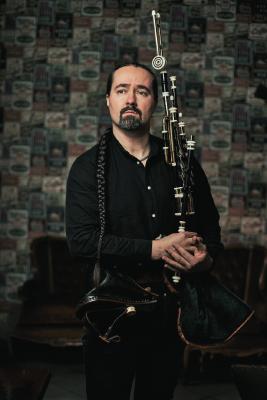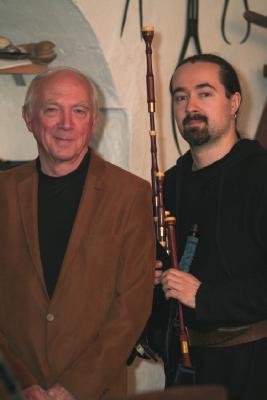The Bagpipe Society
This is the Way

At the very beginning of the cold and completely ‘unspring’ May 2022, my wife. Maria. and I, with three huge suitcases and our two beloved cats Margo and Gargoyle, boarded a plane flying from Sochi to Istanbul. All the time I kept thinking that almost 100 years ago, in an almost identical way (only on steamboats), the best minds and intelligentsia escaped from Russia, leaving from the Bolsheviks and the civil war ... how hard it was for them and now, the Russian customs officials, could, finally, after everything else, exhaust all our nerves!
A huge page of my and Masha's life was turning over to be closed forever but we were full of hopes and expectations of the new and what was waiting for us in the future, in the free world.
But now you need to know everything in order.
I was an ordinary Soviet child who grew up on the outskirts of Moscow. I differed from my peers only in that my father was a sculptor and my mother sent me, aged 6, for recorder lessons at the nearest House of Culture as well to the drawing and painting studio at the Moscow Museum of Fine Arts named after Alexander Pushkin.
When I was seven years old, my parents bought a village house in an ancient small town, Kargopol, in the Russian North. This place, 1200 kilometres from Moscow, was full of new impressions, impressions from nature, which later became my inspiration in my art for the rest of my life. Every house exhibited wooden architecture, furniture and utensils - the heritage of past masters who worked with wood. The Russian North, due to its isolation, was the area least devastated by the Bolsheviks in the entire Soviet Union and it had retained its traditions.
An amazing person named Nikolai Vasilyevich Arkhipov lived in our village, he played the harmonica at holidays, sang some folk songs, and was also famous in area for building wooden boats, I became very friendly with him, not only because he kept rabbits, (which could be fed and petted), but because he made bows and arrows for me, took me fishing almost every day, and also he even took me with him to choose the material for the future boat, told and showed me how to choose a "korga" (a spruce trunk of a certain shape curved near the ground, from which the keel and bow of the boat is made). I must say, the northern boats were nothing like stubby Central Russian boats, they were proud and serious vessels, six and more metres long, these were the direct descendants of the Viking ships and vessels. Now I understand how much my communication and friendship with Nikolai influenced my perception of form, design, understanding of technologies and materials. When you see from childhood the birth of something very complex and beautiful like a boat, from the very beginning and trips to the forest for wood until the moment of launching, it changes you forever, because you touch the tradition and the roots of craftsmanship. Over the years, I was able to formulate this for myself, about the transfer of the "spark", when life brings you together with such a person, someone who carries the knowledge and heritage of centuries-old traditions and then you become its future bearer, the bearer of this "spark".
And from that moment on, my world, which until then had been limited by the monotony of the local architecture, changed a lot. I realised this many years later, having graduated, when I received fragmentary news that friends from my youth had either passed away from drugs, or from hepatitis, or went to the jail. Thanks to the encouragement of my teachers, I passed my exams and eventually won a place at the Russian Academy of Painting, Sculpture and Architecture, to study sculpture.
It can be said that all was "well arranged", at least my parents thought so: the son follows in the footsteps of his father, a famous Russian sculptor, and, in principle, my future was a foregone conclusion had I not, in 1998, gone to a concert of the Moscow group, Sì Mhór, the luminaries of Celtic music at that time
- I was struck in the very heart, in the very soul.
I found the music so fresh and, at the same time, so ancient. Their instruments, songs in English and Gaelic, there was a magical atmosphere in the hall which lingered after the concert finished. There was a red-haired man on the stage with a beard playing a real bagpipe. This man was the legendary Vladimir Lazerson, the pioneer of pipe music in Russia. Back then, of course, I didn't know all this, I was just dumbfounded that such an amazing instrument with such an amazing sound existed in principle.
From that day on, a completely different world appeared in my life, the world of ancient melodies and authentic instruments, parties in underground music clubs in Moscow, a world of a different circle from that of sculptors, painters and my classmates. It was a new, romantic period of my life.
I was a damn lucky person - I met Vladimir, in a conversation it turned out that his cousin drove my father's first car from other region to Moscow, that's how we became friends and from then on he became my mentor, teacher and friend for many years. He had a huge record collection and through this I discovered such giants of music such as Gordon Duncan, Chieftains, Alan Stivell, Malicorne, Tri Yann, Cristy Moore, Planxty, Fred Morrison, Hamish Moore, Davy Spillane and Moving Hearts, Robert Mathieson, Carlos Núñez and many, many others. In addition, my new friend had a collection of musical instruments, and for the first time in my life I saw them up close, I could pick them up, touch them, delve into the combination of materials and their design. Musical instruments have become for me, as person who had studied art and design since early childhood, a real revelation, a separate frontier worlds of music, design and craft.
Then I experienced (and continue to this day) happiness from how many amazing complex instruments embrace the world of Celtic music and the whole
huge family of bagpipes, and their diversity and depth in history captured my imagination. Sculpture, drawing and my studies faded into the background and folk music became an outlet, passion and guiding star, which further illuminated my entire life path. Vladimir Lazerson introduced me to the master of wind musical instruments from St. Petersburg, Sergei Shek, who made my first Galician Gaita for me. The acquisition of this instrument became the point of no return for me from the bagpipe world. I remember how I could not even inflate the bag properly the first time I received it! And if it weren’t for my determination and the instructions of my comrades Vladimir Molodtsov from St Petersburg (who worked with Sergei Shek and sewed bags for him) and Vladimir Lazerson, maybe it could all have ended here. Later, when I was teaching students myself, I saw how people who wanted to learn how to play the bagpipes had taught themselves but not having the right approach, techniques and good teachers to unlock their potential and inspire them, would quit without even starting.
I was lucky that my new friends looked after me and shared their knowledge and tricks, such as setting up drone canes with beard hair, (borrowed from them as I didn’t have my own then!) advice on setting up chanter reeds, how to scrape them correctly, how and in what sequence to season a hide bag and much more. My brain, greedy for everything new, absorbed this invaluable knowledge like a sponge, and I began to feel more and more confident both in playing the Gaita Gallega and in its tuning.
I lived and studied in Moscow, but I spent all holidays and vacations in St. Petersburg with Molodtsov. Soon, I was making plastic chanter reeds for him for the Galician Gaita, and then I started making reeds for myself. I was looking for my own sound. Just having good tuned, sounding was not enough for me, I wanted a powerful and stable timbre. So, a lot of yogurts were eaten, cups were cut into blanks for slips, and all sorts of flea markets were searched in search of old radio antennas for staples.
In pre-internet times, when one went to a friend of friends for a computer, all the information had to be collected bit by bit and written down with a pen in a notebook - my own experiments with diameters, lengths, thicknesses, elasticity of plastics were recorded in this way. When I kept my notes, I also took great pleasure in remembering those manuscripts and treatises, complete with graphics and drawings, from the minds of the past as Leonardo Da Vinci, Benvenuto Cellini and Vasari.
After some time, I learned how to stitch hide bags for bagpipes. Vladimir Molodtsov taught me to choose the right needle for stitching, how to mark the seam for the correct number of stitches, about boiling cobblers wax, mixing different ingredients in one pot, and developing the recipes to get what we

needed. With smoke filling the room and the smells of the various waxes and resins, I like an alchemist.
With Vladimir, we became recognised in all the leather shops in St.
Petersburg. We went to everyone that sold leather and by touching, feeling and breathing through the hides we able to find the one that was elastic and thick enough and at the same time not breathable. It was trial and error - some bags stood up like a stake after the first seasoning, and after drying they rattled like roofing iron, others, on the contrary, became like balloons, swelled and became shapeless. Of course, the path of each handmade product is not easy and sometimes thorny, but in the end we got excellent bags, some of which my students were still playing 10 years later.
Money was tight and in Russia it was not customary for parents to give money to support their student sons. I was often hungry, and the cold of northern winters pierced my bones. But what warmed me was the feeling, deep inside, that I was doing what I loved; cutting and gluing leather, tying reeds, the feeling of something real and a quivering sense of hope. Was what I was doing going to work out? These are the sensations and feelings that I remembered and kept and they helped me to further develop, build, tune and improve my instruments.
Another fortuitous meeting was the of Fyodor Nekrasov, a Moscow musical instrument maker, musician, expert and restorer. I was introduced to him by Vlademir Lazerson, and the visit made an indelible impression on me; a huge number of old and authentic instruments were waiting for restoration, instruments whose names I did not even know hung on the walls and lay on the shelves. Some kind of glue gurgled on a small spirit burner, and the air was filled with scents of wood, shellac, linseed oil and lavender, and in the corners stood tusks of such a size that they could not have belonged to any living animal known to me. Fedor was older than Lazerson, and he was almost twice as old as me.

But despite the difference in ages, these two took and interest in me and inspired me the that path of musical instruments and music was the one for me. It seems that I also inspired them! The support of these relationships has warmed me very much for many years!
In 1999, Fedor made Scottish Smallpipe in Re for me and it was the first Smallpipe made in Russia. He turned the sticks and stocks and I made the bag and reeds and then tuned the instrument. In that Autum, Lazerson introduced me to Alexia Mankovskaya, an opera singer and actress, who was looking for a piper to play in a play based on Pushkin's "Little Tragedies". And so I found myself, after several rehearsals, on stage playing the Scottish Smallpipe at the Stas Namin Musical Theatre. Alexia became the godmother of my professional path as a musician. Finally, I was receiving real money for music!
As I said, I wanted my own sound, and building on what I’d done before and the work I had done, I realized that I was ready to start making bagpipes,.
My father’s sculpture workshop was in an old 19th century mansion in the very heart of historical Moscow. I have vivid childhood connected with this place, the taste of clay and plasticine, and it seems that I often, as a child, got these in my mouth! But I grew up with the tools, the grindstone, anvil, hammers and sledgehammers, chisels and drills of the studio and these were my toys. In the early 2000's, a daring plan began to mature in me. I say daring, because everything related to bagpipes and music in my family and in artistic circles was perceived more as nonsense and whim than as something worthy of attention.
But I wanted a lathe, I was a rebel. By this time, I was playing not only the Galician Gaita, the Scottish Smallpipe, but also a Uilleann pipes practice set. I was really lucky. Irish-Australian musician Greg Dolan came to Russia and played in Alexei Belkin band on Uilleanns made by late Alan Froment. I met with Greg during one of his visits to Moscow and I took him and his pipes to Fyodor Nekrasov's workshop. Greg kindly lent us his Uilleann pipes to exam and measure. And so Greg became my first teacher for the Uilleann and Irish music and the “spark” was passed on again.

Almost on the same day, I ordered from Fedor an Uilleann chanter and all the wooden parts for the practice set, and a few months later, we assembled a fully-fledged Uilleann bagpipe, the first in Russia. So now, I start to learn the Uilleann pipes and between 2000-2005, I became a session musician in various groups, as well as playing with Vladimir Lazerson. Together, along with a fiddle player from Bavaria Anna Seubert we assembled my first fully-fledged folk band called Na Caora Aithil (Juniper Berries).
I continued my amazing friendship with Fyodor Nekrasov. We
spent hours in his talking about wood, music, pitches, bores, machine tools and everything in the world but whilst never having had a single lesson from him, I saw and learned so much from him during this time – it was better than any training.
At the beginning of 2005, I moved to a wonderful studio in Sokolniki, a district of Moscow. It belonged to my godfather, Alexander Lakhno, who was a sculptor and good friend of my father. He transferred his workshop to me and so I became the happy heir and owner of as many as 124 square meters!
I was 25 and a new chapter was starting. Having divorced from my first wife, I found myself in a new place where I could live and work. My sadness of a family aspirations quashed, my passion for making and playing music pulled me through. Despite graduating from the Fine Art Academy, my future could have followed the slow, low-paid and servile path of working for ’eminent’ sculptors who moved in government circles. But instead, I gained the realisation that my journey so far had given me the strength to go my way of music, making bagpipes and flutes and the fine art of sound.
In the next chapter of my story, the reader will learn how I created three bagpipe workshops in Russia, and one in Spain, and how I got customers from around the world. Now there is not one in Russia. The "tightening the screws"
by the government affected not only society, but also the musical and artistic environment, and this led to our immigration to Italy. Now I have plans to build a new workshop in a new world to me.
To be continued…
https://anistratovbagpipes.com/
- Data Processing Notice (GDPR)
-
@BagpipeSociety on X (formally known as Twitter)
-
TheBagpipeSociety on Instagram
-
 BagpipeSociety on Facebook
BagpipeSociety on Facebook
Something wrong or missing from this page? Let us know!
